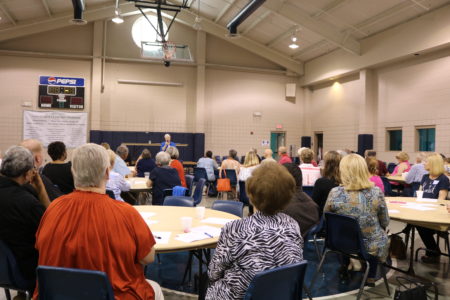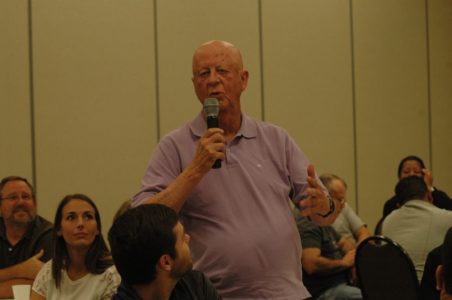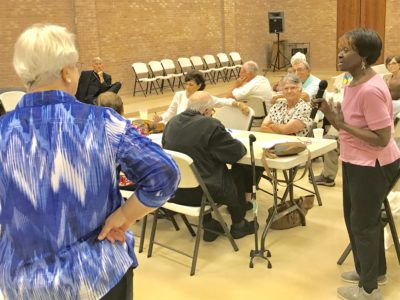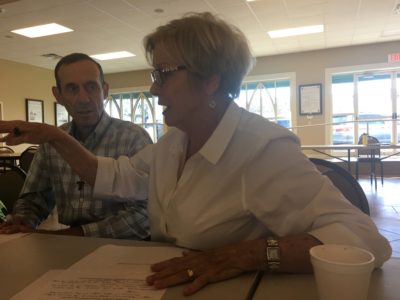By Maureen Smith
MADISON – Bishop Joseph Kopacz hosted four sessions open to the public to hear concerns and responses to the sex abuse crisis in the church today. During the first, at Tupelo St. James Parish he assured people he didn’t have a prepared agenda. “I didn’t come here tonight to speak or even just to answer questions thoroughly, because that would prevent me from listening to your concerns. I am here to listen,” he said.
Sister Dorothy Heiderscheit, CEO of the Southdown Institute and former Catholic Charities counselor, talked about the dynamics of sex abuse including some myths and realities of pedophilia. “Sexual abuse isn’t about sex. It’s about power – destructive power,” she noted. She began each session this way, noting that there is no correlation between homosexuality and pedophilia or abuse.

MADISON – Sixty people listen to Dr. Dorothy Heiderscheit describe the format for the listening session at St. Francis of Assisi Parish on Saturday, Oct. 6. (Photo by Maureen Smith)
At each session, participants were asked to share at their tables how they were feeling, what they are doing to sustain their faith and what they think the church needs to move forward. Table representatives then shared with the room.
Many of the questions centered on concerns about the influence of homosexuality in modern culture. Others expressed concern about priestly formation and helping select and support the right seminarians for the priesthood.
St. James parishioner Nina Sevier asked if there might be a better way to screen seminarians. Bishop Kopacz responded by citing Pope Saint John Paul II’s Pastores Dabo Vobis, in which he described four pillars of priestly formation, including human, spiritual, intellectual, and pastoral. The human dimension, as the bishop explained, is to help the seminarian become a man of integrity, while the spiritual dimension is intended to help him grow in relationship to Christ through prayer and contemplation. Seminarians deepen their faith through the study of theology and philosophy in the intellectual dimension of formation, and participate in supervised pastoral assignments to help them become good servants.

TUPELO – Roy Yeager of St. James Parish, asks a question at the Thursday, Oct. 4 session. (Photo by Galen Holley)
St. James parishioner Roy Jaeger suggested that this crisis might also present an opportunity for renewal in the Church.
In Cleveland on Friday night, 18 people shared their hurt, anger, disillusionment and disgust. One participant said people are reluctant to give money to the church for fear their money will be used in a settlement and cover-up of abuse.
Bishop Kopacz reassured the people that no large settlements are currently being paid, though support is being offered to victims through the offering of counseling services, at a cost to the diocese. The bishop’s hope is that as this wound is being healed in the Church, the Church will in turn be able to offer to all of society’s families and communities the ability to be more aware of the needs of and to be vigilant on behalf of our society’s vulnerable children, youth and adults.
Celeste Zepponi, of Clarksdale St. Elizabeth Parish, called the session “respectful, strong, frank and heartfelt.”

CLEVELAND – Rose Mell from Greenville Sacred Heart Parish speaks at the listening session at Our Lady of Victories Parish on Friday, Oct. 5. (Photo by Father Kent Bowlds)
Sixty people attended the Madison session. Several people expressed their support for priests currently in ministry, saying they felt bad that these priests are being associated with abusers in the public eye. One table asked about the role lay women play in diocesan leadership. Bishop pointed out that in the Diocese of Jackson, many leadership positions – including the chancellor, coordinator for the protection of children, director of faith formation, director of the Catholic Foundation and the director of communications among others – are held by lay women.
In Natchez on Sunday afternoon, 25 people came to share their concerns and raised similar questions.
Attendee of St. Richard Parish asked for a little more information about the diocesan review board tasked with examining claims of abuse brought forward many years later. Bishop called on Father Kevin Slattery, vicar general and Msgr. Elvin Sunds, the previous vicar general, who talked about the makeup of that board, which includes a psychologist, counselors, social workers and a pediatrician. Bishop said the board met without him when the most recent case of abuse was brought to light – showcasing that they truly operate independently.

NATCHEZ – Charles Garrity and Mary Jane Gaudet speek to their table in open discusion at the listening session at St. Mary Basilica Parish on Sunday, Oct. 7. (Photo by Tereza Ma)
In her opening remarks, Sister Heiderscheit referred to the example of St. Francis of Assisi, noting that he was a reformer and man of great prayer. Francis presented a model of holiness at a time when the church was in need of reform, she said. Perhaps the present moment is similar in some ways.
(Galen Holley of New Albany St. Francis, Fr. Kent Bowlds, pastor of Cleveland Our Lady of Victories and Tereza Ma contributed to this report.)
